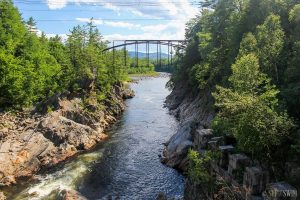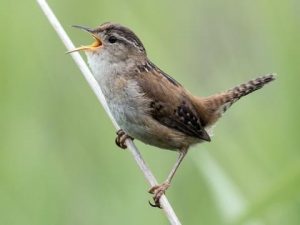Posted Nov. 2018
By Jessica Casterline, MS Environmental Science and Policy Student, Edited by faculty advisor Mary Ann McGarry
View of Livermore Falls below.

Dynamic Tourist Site
Livermore Falls, located on the Pemigewasset River, is a dynamic tourist and educational site. Spend a day enjoying the sandy beaches, powerful waterfall, gorgeous rocks and deep clear water. Livermore Falls has everything you need to have a relaxing day. And, if you are interested in learning about the rich, colorful human and natural history, read more of the Livermore Falls blog posts produced by the environmental outreach and communication class at Plymouth State University. Offering diverse geology, hydrology, ecology, forestry, fishery and archeology stories, Livermore Falls has much to offer. .
This blog post is about the different habitats, wildlife and plants at Livermore Falls.
Presence of Poison Ivy
Let’s face it; many of us have had our run ins with poison ivy, but have you ever wondered if there are ecological benefits of the plants? Poison Ivy (Toxicodendron radicans) is actually vital to the environment and has several important roles. Poison ivy roots are like a spider web, only stronger. They hold the soil in place very effectively and prevent water and wind erosion. This is especially important near the Pemigewasset River, where floods occur. There are no dams in place above Livermore Falls, which increases the chance of floods. In addition to this ecosystem service, poison ivy produces a berry in the fall season. Many birds rely on the berry, and if you ever wondered how poison ivy spreads, you can now blame it on the birds.
There is an abundance of poison ivy at Livermore Falls, but do not let this scare you off! As long as you stay on the paths, you will not encounter poison ivy, but it is important to know it is there and how to identify it.
Myths Versus Facts
There are many myths about poison ivy; so let’s set the record straight. First and foremost, poison ivy, poison sumac and poison oak all have the same oil called “urushiol.” This oil is what gives people an allergic reaction, or rash.
- Myth: Scratching Poison ivy blisters will spread the rash.
Fact: The fluid from your blisters will not spread the rash. The rash can only be spread by urushiol. That is why it is important to clean any infected area to remove the oil.
- Myth: Poison ivy rashes are contagious.
Fact: The rash itself is not contagious, however if the oil is still on the infected area, it can easily spread the rash.
- Myth: After an initial reaction, I cannot get a poison ivy rash ever again.
Fact: Although we wish this were true, it is not. People generally become more sensitized with each encounter and can therefore have worse reactions to poison ivy.
- Myth: Once allergic, always allergic to poison ivy.
Fact: A person’s sensitivity changes over time. Sensitivity can even change from season to season. Just like any allergy, if you were allergic as a child, you may grow out of it as an adult, or experience worse cases.
- Myth: Dead poison ivy plants are no longer toxic.
Fact: The oil, urushiol, can remain active on a surface for up to five years! Avoid handling dead poison ivy and wash any surface that comes in contact with it.
If you plan to spend time at Livermore Falls, or anywhere in the outdoors, it is important to be able to recognize poison ivy, poison sumac and poison oak. Poison ivy has 3 pointed leaves that are mostly green, but can also be red. The leaves are shiny, due to the urushiol. The plant can vary in form which means poison ivy can grow low to the ground, or as a vine high above your head. If you came in contact with one of the three plants, immediately wash the infected area with soap and water; the sooner the better! (Zanfel.com).
Rule of Thumb: Leaves of 3, Leave it be!
A diagram of how to identify poison ivy, poison oak and poison sumac. Notice how only poison ivy and poison oak have 3 leaves, while poison sumac has more.

Habitats
There are two main ecosystems at Livermore Falls: freshwater riverine, and forest habitats.
Native plants, such as blueberry, shadbush (also known as Juneberry) and elderberry exist at Livermore Falls. These plants provide food for deer, birds and black bears, that’s right bears! Bears have been spotted down stream from Livermore Falls enjoying the Pemigewasset River. You can also keep an eye out for North American beavers, otters, bullfrogs, snapping turtles, black ducks and salty skimmer dragonflies. Endangered birds can also be seen at Livermore Falls including:
- Golden eagle

- Upland sandpiper

- Northern harrier

- Sedge wren

- Common Nighthawk

Also, look out for loons, bald eagles and peregrine falcons, who also depend on the Pemigewasset River for resources. (NHDES).
Conclusion
Livermore Falls is a compelling site for tourists or locals to learn more about the Pemigewasset River and surrounding forest ecosystems. Livermore Falls is also a great destination for outdoor recreation. It provides dynamic habitats and resources for all sorts of animals. Remember, this is a home to animals too, which is why it is important to leave the area clean and serene. It is vital to be respectful of Livermore Falls, so please abide by the rule: leave no trace.
Resources:
“Poison Ivy, Oak, and Sumac Rash Facts & Myths.” Poison Ivy, Poison Oak, and Poison Sumac Rash Facts and Myths – Zanfel Laboratories, Zanfel, 2018, www.zanfel.com/help/rashfaq.html.
“Environmental Fact Sheet: The Pemigewasset River.” NHDES, New Hampshire Department of Environmental Services, 2017, www.des.nh.gov/organization/commissioner/pip/factsheets/rl/documents/rl-9.pdf.